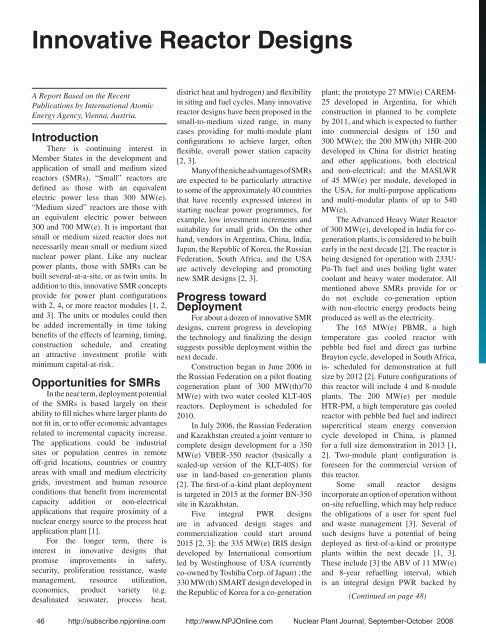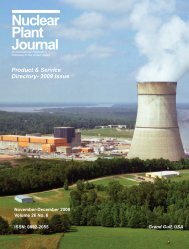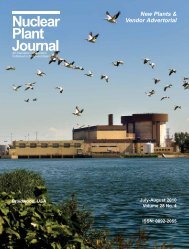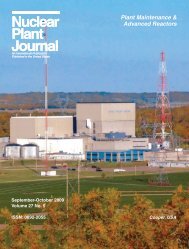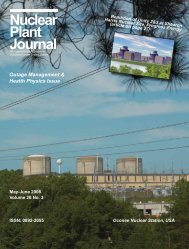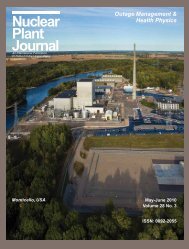Nuclear Plant Journal - Digital Versions
Nuclear Plant Journal - Digital Versions
Nuclear Plant Journal - Digital Versions
Create successful ePaper yourself
Turn your PDF publications into a flip-book with our unique Google optimized e-Paper software.
Innovative Reactor Designs<br />
A Report Based on the Recent<br />
Publications by International Atomic<br />
Energy Agency, Vienna, Austria.<br />
Introduction<br />
There is continuing interest in<br />
Member States in the development and<br />
application of small and medium sized<br />
reactors (SMRs). “Small” reactors are<br />
defined as those with an equivalent<br />
electric power less than 300 MW(e).<br />
“Medium sized” reactors are those with<br />
an equivalent electric power between<br />
300 and 700 MW(e). It is important that<br />
small or medium sized reactor does not<br />
necessarily mean small or medium sized<br />
nuclear power plant. Like any nuclear<br />
power plants, those with SMRs can be<br />
built several-at-a-site, or as twin units. In<br />
addition to this, innovative SMR concepts<br />
provide for power plant configurations<br />
with 2, 4, or more reactor modules [1, 2,<br />
and 3]. The units or modules could then<br />
be added incrementally in time taking<br />
benefits of the effects of learning, timing,<br />
construction schedule, and creating<br />
an attractive investment profile with<br />
minimum capital-at-risk.<br />
Opportunities for SMRs<br />
In the near term, deployment potential<br />
of the SMRs is based largely on their<br />
ability to fill niches where larger plants do<br />
not fit in, or to offer economic advantages<br />
related to incremental capacity increase.<br />
The applications could be industrial<br />
sites or population centres in remote<br />
off-grid locations, countries or country<br />
areas with small and medium electricity<br />
grids, investment and human resource<br />
conditions that benefit from incremental<br />
capacity addition or non-electrical<br />
applications that require proximity of a<br />
nuclear energy source to the process heat<br />
application plant [1].<br />
For the longer term, there is<br />
interest in innovative designs that<br />
promise improvements in safety,<br />
security, proliferation resistance, waste<br />
management, resource utilization,<br />
economics, product variety (e.g.<br />
desalinated seawater, process heat,<br />
district heat and hydrogen) and flexibility<br />
in siting and fuel cycles. Many innovative<br />
reactor designs have been proposed in the<br />
small-to-medium sized range, in many<br />
cases providing for multi-module plant<br />
configurations to achieve larger, often<br />
flexible, overall power station capacity<br />
[2, 3].<br />
Many of the niche advantages of SMRs<br />
are expected to be particularly attractive<br />
to some of the approximately 40 countries<br />
that have recently expressed interest in<br />
starting nuclear power programmes, for<br />
example, low investment increments and<br />
suitability for small grids. On the other<br />
hand, vendors in Argentina, China, India,<br />
Japan, the Republic of Korea, the Russian<br />
Federation, South Africa, and the USA<br />
are actively developing and promoting<br />
new SMR designs [2, 3].<br />
Progress toward<br />
Deployment<br />
For about a dozen of innovative SMR<br />
designs, current progress in developing<br />
the technology and finalizing the design<br />
suggests possible deployment within the<br />
next decade.<br />
Construction began in June 2006 in<br />
the Russian Federation on a pilot floating<br />
cogeneration plant of 300 MW(th)/70<br />
MW(e) with two water cooled KLT-40S<br />
reactors. Deployment is scheduled for<br />
2010.<br />
In July 2006, the Russian Federation<br />
and Kazakhstan created a joint venture to<br />
complete design development for a 350<br />
MW(e) VBER-350 reactor (basically a<br />
scaled-up version of the KLT-40S) for<br />
use in land-based co-generation plants<br />
[2]. The first-of-a-kind plant deployment<br />
is targeted in 2015 at the former BN-350<br />
site in Kazakhstan.<br />
Five integral PWR designs<br />
are in advanced design stages and<br />
commercialization could start around<br />
2015 [2, 3]: the 335 MW(e) IRIS design<br />
developed by International consortium<br />
led by Westinghouse of USA (currently<br />
co-owned by Toshiba Corp. of Japan) ; the<br />
330 MW(th) SMART design developed in<br />
the Republic of Korea for a co-generation<br />
plant; the prototype 27 MW(e) CAREM-<br />
25 developed in Argentina, for which<br />
construction in planned to be complete<br />
by 2011, and which is expected to further<br />
into commercial designs of 150 and<br />
300 MW(e); the 200 MW(th) NHR-200<br />
developed in China for district heating<br />
and other applications, both electrical<br />
and non-electrical; and the MASLWR<br />
of 45 MW(e) per module, developed in<br />
the USA, for multi-purpose applications<br />
and multi-modular plants of up to 540<br />
MW(e).<br />
The Advanced Heavy Water Reactor<br />
of 300 MW(e), developed in India for cogeneration<br />
plants, is considered to be built<br />
early in the next decade [2]. The reactor is<br />
being designed for operation with 233U-<br />
Pu-Th fuel and uses boiling light water<br />
coolant and heavy water moderator. All<br />
mentioned above SMRs provide for or<br />
do not exclude co-generation option<br />
with non-electric energy products being<br />
produced as well as the electricity.<br />
The 165 MW(e) PBMR, a high<br />
temperature gas cooled reactor with<br />
pebble bed fuel and direct gas turbine<br />
Brayton cycle, developed in South Africa,<br />
is- scheduled for demonstration at full<br />
size by 2012 [2]. Future configurations of<br />
this reactor will include 4 and 8-module<br />
plants. The 200 MW(e) per module<br />
HTR-PM, a high temperature gas cooled<br />
reactor with pebble bed fuel and indirect<br />
supercritical steam energy conversion<br />
cycle developed in China, is planned<br />
for a full size demonstration in 2013 [1,<br />
2]. Two-module plant configuration is<br />
foreseen for the commercial version of<br />
this reactor.<br />
Some small reactor designs<br />
incorporate an option of operation without<br />
on-site refuelling, which may help reduce<br />
the obligations of a user for spent fuel<br />
and waste management [3]. Several of<br />
such designs have a potential of being<br />
deployed as first-of-a-kind or prototype<br />
plants within the next decade [1, 3].<br />
These include [3] the ABV of 11 MW(e)<br />
and 8-year refuelling interval, which<br />
is an integral design PWR backed by<br />
(Continued on page 48)<br />
46 http://subscribe.npjonline.com http://www.NPJOnline.com <strong>Nuclear</strong> <strong>Plant</strong> <strong>Journal</strong>, September-October 2008


